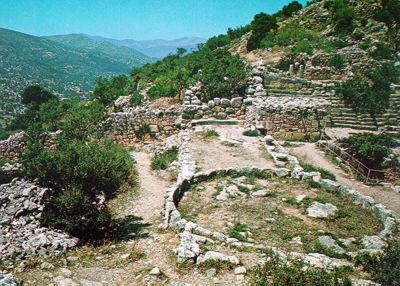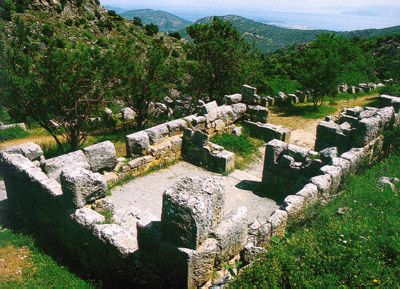Lato (GR: Λατώ) was one of the most important Doric city-states in Crete, although it must have existed before the "Coming of the Dorians". It is built on a saddle between two hills, at a site protected by possible attacks but also with a splendid view over a large area of the Mirambello Bay. It is possibly mentioned in the Linear B tablets as RA-TO. It was named after Leto (Lato is the Doric type), mother of Apollo and Artemis, although the main goddess worshipped in the city was Eileithyia, who was also depicted on the coins cut by the city.
Lato was the birth-place of Nearchos, the admiral of Alexander the Great. Before the end of the 3rd century B.C., the inhabitants of Lato participated in the League of the Cretan cities and shared the same laws. Lato made many alliances with Rhodes, Teos, and king Eumenes of Pergamon. However, it was in continuous conflict with the neighbouring city of Olous, for the arrangement of the borders between them. The harbour of the city was Lato pros Kamara (modern Aghios Nikolaos), which was so flourishing by the middle of the 2nd century A.D. that the administrative centre was transferred there and Lato was subsequently abandoned.
The English admiral Th. Spratt, in his work "Travels in Crete", published in 1865, mentions that he located the remains of the ancient city on the hill of Goulas, but wrongly identified them as the remains of Olous or Oleros. The archaeologists F. Halbherr, L. Mariani and A. Taramelli, visited the site and identified it as ancient Lato. In 1894-96, A. Evans conducted a small-scale investigation. Systematic excavation started in 1899-1901 by the French School of Archaeology, with J. Demargne, was resumed in 1968 by P. Ducrey, O. Picard, and B. Chatzimichali, and lasted until the 1970s.
The most important monuments of the site are:
The fortified city on the saddle between two hills. It had a steep double acropolis with fortification walls. The main gate had three successive entrances and two internal square courtyards so as to control the incoming. At this point started a street with almost eighty steps, which led up to the Agora. On its north side was a wall with towers, and private houses built on successive terraces, so that the roof of the lower ones was the actually the court and the way of access to the upper ones. These houses and others in the area of the north acropolis were simple in plan, usually with two square rooms having a hearth at the centre. Subterranean cisterns, cut in the rock were used for the collection of rain water for the needs of the household.
Industrial workshops, such as an interesting dyehouse were located on the south side of the street.
The "Agora" is an open space, including a deep square cistern, once roofed, and a small rectangular temple without columns, with a single chamber, probably unroofed, where many figurines of the 6th century B.C. were found.
A rectangular platform with two steps, partly cut in the rock, is located to the south of the "Agora".
A Doric stoa with a step on three of its sides was built to the west.
The Prytaneion.

A monumental complex, reminiscent of an ancient theatre, lies in the north: seven tiers are divided by narrow staircases into three wings, seating almost eighty persons. It was probably used for public discussions or for watching spectacles, but at the same time the steps led to the upper terrace, where, through a peristyle court and a narrow doorway, one could enter the actual "Prytaneion". Two high retaining towers, built of large blocks, surrounded the building and supported the one lying at a higher level. In the central room of the Prytaneion there was an "eschara" (hearth) burning day and night, surrounded by two-stepped benches, each seating eight persons. This was the place where the "kosmioi", the notables of the city dined and held their meetings. Two rooms to the north housed the archives of the city.
The Temple.

To the south of the "Agora", on a terrace supported by a retaining wall, are preserved the ruins of the city's large temple (measuring 10 x 16 m.), which comprises a square sekos (cella) - where the base of the deity's cult statue was found in situ, with an illegible inscription - and a rectangular prodomos (antechamber). An altar with two steps lies in front of the temple.
To the east of the temple, at a lower level, there was a "theatral area" with steps partly built and partly cut in the rock, with a seating capacity of 350 persons. Beside it lies an exedra, while another platform formed the skene (stage), with an altar to the west.
Source:
The Hellenic Ministry of Culture
For visitors
Administrative Information
Τ.Κ. 72051, Kritsa, Mirabello (Prefecture of Lasithi)
Telephone: +30 28410 22462 - 28361 - 90511
Fax: +30 28410 25115
Email: efalas@culture.gr
Tickets
Full: €2, Reduced: €1
Open
08:00-15:00
Monday: closed
Access
By car or bus to the nearest village of Kritsa (Lassithi), then by taxi or a 4 km. walk.